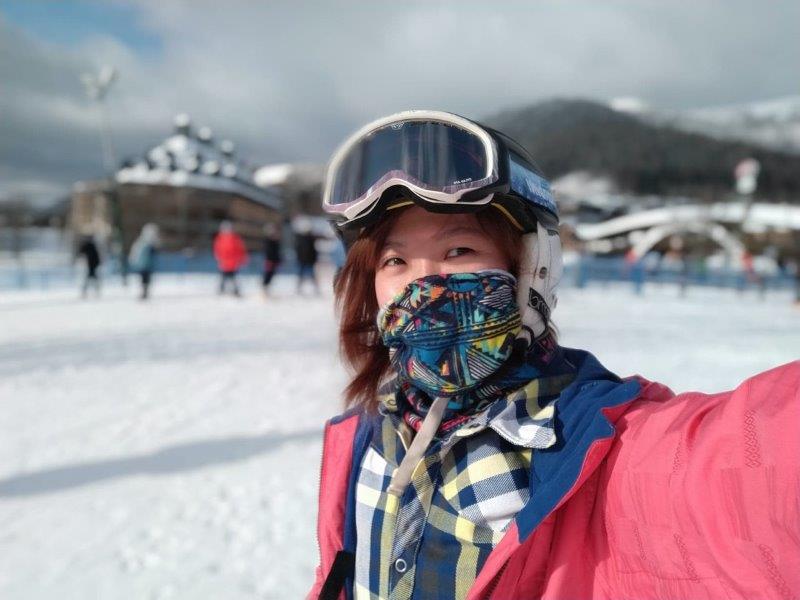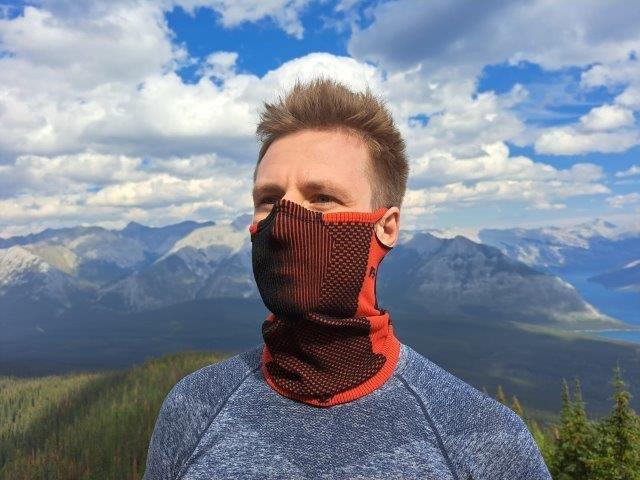Winter is a wonderful season to explore the great outdoors. From shimmering snow to ice-capped mountains, the outdoors in winter can be incredibly beautiful – not to mention, it’s the only time you can enjoy activities like skiing or snowboarding!
As adventure enthusiasts, we’ve always made sure to not venture out into the icy temps without our trusty neck warmers. This small yet effective gear can keep you warm and cozy when braving the outdoors, protecting your throat so that you stay safe and healthy in the face of the bitter cold.
In this guide, we’ll share everything we know from our personal outdoor experiences using and buying different neck warmers, from materials to fit and everything in between.

Purpose of a Neck Warmer
The main purpose of a neck warmer, sometimes called a neck gaiter for winter, is to protect your neck from the harsh elements. In most cases, this can include blistering winds, freezing temperatures, or even the blazing sun.
As versatile pieces of clothing, neck warmers can be used on your neck, head, face, and even wrists. Really, you can wrap them around anything that fits that you want to keep warm.
Neck warmers are important pieces of gear that not only provide warmth and comfort, but can also stylishly accessorize your outdoor wardrobe.
Ways to Wear a Neck Warmer
As mentioned before, neck warmers are extremely versatile. There’s no shortage of ways to wear a neck warmer, but here are some of the most popular ways:
- Hood: For full head and neck protection against the cold.
- Scarf: A classic way to keep your neck warm.
- Face Covering: Great for shielding your face from the wind, sun, rain and dust.
- Balaclava: Offers full-face coverage, ideal for extremely cold conditions.
- Headband: Perfect for keeping hair and sweat out of your eyes during outdoor exercise.
- Wristband: Handy for wiping sweat or shielding your wrists from the elements.
Top Uses of Neck Warmers
If you plan to do any outdoor activities, neck warmers are here to save the day. Going out in the cold without a neck warmer is not only uncomfortable, but also potentially dangerous depending on the temperature outside.
Neck warmers are important to keep comfortable and prevent conditions like frostbite when enjoying activities like these:
- Hunting: A neck warmer can help you stay camouflaged and protected from the elements. The last thing you want is for a deer to hear your chattering teeth!
- Fishing: Fishing trips often involve some long hours sitting by the water. Though peaceful, a neck warmer can keep you even cozier and focused on your surroundings.
- Skiing/Snowboarding: These are particularly important to bring a neck warmer with you. Skiing and snowboarding not only involves surrounding yourself with snow and ice, but you also face freezing wind biting you in the face. A neck warmer will protect you from both the snow and freezing wind burn.
- Outdoor Exercise: If you like to run or cycle year-round, a neck warmer is truly invaluable. No more rushing home to heat back up after a chilly run.
- Hiking: You truly never know what you might face on a hike. Neck warmers are a lightweight solution for various terrains and weather conditions, so you’re always prepared.
- Camping: Keep your neck and face warm for a cozy sleep in your tent at night. We also find them helpful to stay warm as you leave your tent to cook, adventure, or use the restroom.

Top Features to Consider in Neck Warmers
Before buying just any neck warmer, we recommend considering the different features neck warmers have. Here are some of the top features you should consider:
Neck Warmer Materials
Not all neck warmers are built the same. The material you choose for your neck warmer can make a huge difference in terms of comfort and protection.
Some of the most common materials for neck warmers include:
- Microfiber: Soft and lightweight, best for mild conditions. Very breathable as well.
- Polyester: Extremely affordable and quick-drying. Great for year-round adventures, especially in sunny conditions.
- Polyester Spandex Blend: Combines flexibility with moisture-wicking properties. A bit more expensive, but still affordable.
- Wool: Offers superior warmth and natural odor resistance. Excellent for snowboarding or skiing, where you need to stay warm but may also sweat. Naturally breathable, but often more expensive than other materials.
- Synthetic: Durable and versatile, great for varied conditions. Also pretty affordable compared to other materials.
- Fleece: Exceptionally warm and cozy, ideal for extreme cold. A great choice for hiking or camping in the winter without breaking the bank.

If you can’t pick just one, that’s okay – we recommend bringing a few different ones on your trip anyway. You never know when one might get dirty or wet from snow!
Design
The overall design of your neck warmer is important too. Just because it uses a good material doesn’t mean it’s built well! Here are some features to consider when looking at neck warmer design.
Stretchiness
Because neck warmers often involve layering or wrapping, you need to make sure your neck warmer is fairly stretchy. Stretchiness ensures that your neck warmer is snug, but still comfortable when worn.
Polyester spandex blends tend to be best for stretchiness, but synthetic and microfiber materials are great too. Wool and fleece can be stretched depending on how they’re woven.
Grip
Some neck warmers have added grip inside, whether through a band or other texture on the inside of the fabric. This grip is important to keep the neck warmer exactly where you want it on your head or face. Grip is particularly important for active sports like snowboarding, where the wind or snow condensation could easily pull the fabric down your face.
However, some people don’t prefer neck warmers with grip as they find the added friction to be uncomfortable or rigid. Choose one that feels the best for you.
Insulation
The material and thickness of your neck warmer will ultimately decide how effective it is at insulating heat. The main purpose of your neck warmer is to protect you from the cold, so make sure that there are no holes in the material and that wind doesn’t easily pass through it.
In general, materials like fleece and wool are the best at insulation while still remaining breathable. Other fabrics can insulate too, but it may create a thicker neck warmer.
Durability
Beyond warmth, you want to make sure your neck warmer is durable. After all, it’s going to be standing up to some pretty tough elements!
We recommend looking your neck warmer over for strong stitching and thicker materials to ensure longevity. You should also make sure the fabric can be washed easily, as more delicate fabrics may not withstand a washing machine over time.

Neck Warmer Style
There are many different styles of neck warmers out there. Here are a few of the most common:
- Classic Tube: This style is straightforward, focusing on functionality and versatility. Ideal for those who prefer simplicity and effectiveness.
- Hooded: Attached to a hood, this style offers additional warmth and protection for your head, which we recommend for more severe weather conditions.
- Zippered: Comes with a zipper, which allows you to adjust the coverage depending on the temperature or your activities.
- Printed/Patterned: Neck warmers come in all sorts of colors and patterns. Find ones that are attractive to you that will go well with your outdoor wardrobe. For hunters, consider camouflage options.
Neck Warmer Size and Fit
Remember: your neck warmer won’t do much good if it doesn’t even fit right!
Not all neck warmers are one-size-fits-all.
Most neck warmers are somewhere between 8-14 inches long. However, some can go much longer than this, all the way up to 28 inches! Choose the length you prefer based on how many times you want to wrap it around yourself.
If you’re shopping for a small child, we recommend going with 8-inch lengths so they aren’t too short, and they can be used a little longer as your child grows.
Your neck warmer should fit snugly without being too tight. You don’t want any cold air to get behind it, but you also don’t want to be uncomfortable. Stretchier materials will help with this.
Weather Resistance
The whole point of your neck warmer is protection against the elements. Without this, your neck warmer really just becomes a fashion accessory. And you’ll still be cold.
Here are the top points of protection your neck warmer will need:
- Sun: Even if it’s cold, the sun’s UV rays can still burn you. Look for UPF-rated materials that will protect your neck and face from winter sunburns.
- Wind: Wind-resistant fabrics are a must, especially for those looking to snowboard or ski. You should also consider fabrics with added grip to keep the fabric from sliding down your face as you zoom down the mountainside. However, wind protection is still important for those who are simply exploring the great outdoors in the winter.
- Dust: The last thing you want is to be choking on dust during your travels! Make sure you choose a neck warmer that can double as a face cover. You’ll also want to ensure the material is thick enough that you can’t breathe any dust through the fabric.
- Cold Temperatures: The most important things to consider here are insulation and wind-blocking abilities. As mentioned before, wool and fleece tend to be the warmest, but could be considered overkill in average chilly temps. Other lightweight materials like microfiber are better for those average fall days.
Price
Price can vary on neck warmers depending on the size, material, and style you pick. The brand can also make a huge impact on the price set for the warmer.
In general, plan to spend anywhere between $10-20 on your average neck warmer. They’re really quite affordable, which is great given how necessary they are for your comfort and health outdoors. For more expensive materials like merino wool, you may pay anywhere between $25-40.
Neck Warmer Recommendations and Reviews
Neck Warmers by Season
Neck Warmers by Activity
- Best Skiing Neck Warmer
- Best Snowboarding Neck Gaiter
- Best Motorcycle Neck Gaiter
- Best Cycling Neck Gaiter
- Best Running Neck Gaiter
- Best Fishing Neck Gaiter
- Best Hunting Neck Gaiter
Final Thoughts
Choosing the right neck warmer can greatly enhance your outdoor experience. Neck warmers help provide comfort, protection, and style during your adventures, so it’s important to invest in some good ones.
Before making a purchase, consider the activity, the conditions you’ll be facing, and your personal preferences when selecting the perfect one for your adventures. Remember that it’s all about embracing the journey – and a good neck warmer will surely make yours more enjoyable!
To see some great examples of our favorite neck warmers out there, check out our review on the Best Ski Neck Warmer for the outdoors!
